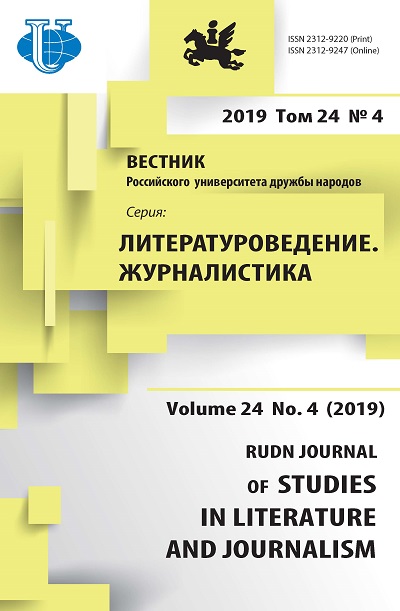“The Kashmir poems” of Qudsi Mashhadi (1582-1646): the problem of genre definition
- Authors: Akimushkina E.O.1
-
Affiliations:
- Lomonosov Moscow State University
- Issue: Vol 24, No 4 (2019)
- Pages: 681-690
- Section: LITERARY CRITICISM
- URL: https://journals.rudn.ru/literary-criticism/article/view/23068
- DOI: https://doi.org/10.22363/2312-9220-2019-24-4-681-690
Cite item
Full Text
Abstract
In the Persian poetry of the postclassical period one can fi nd a signifi cant number of relatively little studied works, which are dedicated to Kashmir, a region located in the north-west of the Indian subcontinent. At present, there is no consensus in Iranian studies regarding the genre defi nition of “Kashmir poems”, which led to consider this problem in detail. The author of the article made an attempt to identify the genre of “the Kashmir poems”, written by Qudsi Mashhadi, whose works have never drawn interest of Russian scholars. Upon analyzing the main motifs and topics of Qudsi’s poems, the author come to the conclusion that they refer to descriptive poetry, and the descriptive motifs are placed either in the context of praise or complaints. The genetic basis of such poems is mainly formed by descriptive, panegyric and calendar poetry. It should be pointed out, that Qudsi’s “Kashmir poems” don’t go back to the shahrashub genre. The presence of similar motifs in “the Kashmir poems” of Qudsi and poems, belonging to the shahrashub genre, indicates that the motifs were transferred from genre to genre - from the shahrashub genre to the genre of description ( vasf ) or from object to object (from the description of cities to the description of regions and vice versa), which refl ects the very essence of the transformation of motifs within the framework of the canonical type of artistic creativity. The analysis has also shown that the term “ bucolic ” doesn’t correspond to the genre nature of Qudsi’s “Kashmir poems”. The study of the genesis and evolution of such poems is intended to contribute to the reconstruction of formation of Persian landscape lyrics of the XIXth century.
About the authors
Ekaterina O. Akimushkina
Lomonosov Moscow State University
Author for correspondence.
Email: eakimushkina@mail.ru
SPIN-code: 3045-9790
PhD (Philology), Associate Professor at the Department of Indian Philology, Institute of Asian and African Studies
11 Mokhovaya St., bldg. 1, Moscow, 125009, Russian FederationReferences
- Vorozheikina Z.N. Isfakhanskaya shkola poetov i literaturnaya zhizn’ Irana v predmongol’skoe vremya (XII–XIII v.) [Isfahan school of poets and the literary life of Iran in the pre-Mongolian period (XII–XIII centuries)]. Moscow: Nauka Publ., Glavnaya redaktsiya vostochnoi literatury, 1984. (In Russ.)
- Bertel’s E.E. Istoriya persidsko-tadzhikskoi literatury: izbrannye trudy [History of Persian-Tajik literature: the selected works]: in 5 vols. Vol. 1. Moscow: Nauka Publ., Glavnaya redaktsiya vostochnoi literatury, 1960. (In Russ.)
- Reysner M.L. Persidskaya liroepicheskaya poeziya X – nachala XIII veka. Genezis i evolyutsiya klassicheskoi kasydy [Persian lyrico-epic poetry (X – the beginning of XIII century). Genesis and Evolution of Classical Qasida]. Moscow: Natalis Publ., 2006. (In Russ.)
- Sami-Uddin Ahmad. Haji Muhammad Jan Qudsi of Mashhad, His Life, Times and Works: dissertation. Aligarh: Muslim University, 2002.
- Losensky P. Qodsi Mašhadi. Encyclopædia Iranica. 2006. http://www.iranicaonline.org/ articles/qodsi-mashadi (accessed: 08.05.2019).
- Sharma S. Kashmir and the Mughal Fad of Persian Pastoral Poetry. Borders. Itineraries on the Edges of Iran. Eurasiatica. Quaderni di studi su Balcani, Anatolia, Iran, Caucaso e Asia Centrale. Vol. 5. Venezia: Edizioni Ca’Foscari-Digital Publishing, 2016. Pp. 183–202. https://edizionicafoscari.unive.it/en/edizioni/libri/978-88-6969-101-0/ kashmir-and-the-mughal-fad-of-persian-pastoral-poe/ (accessed: 08.05.2019).
- Qudsi Mashhadi. Masnavi № 2. Ganjoor. https://ganjoor.net/ghodsi/masnavigm/sh2/ (accessed: 29.04.2019]. (In Persian.)
- Zumphor P. Essai de poétique médiévale. Paris: Éd. du Seuil, 1972. 518 p. (In French.)
- Kudelin A.B. Klassicheskaya arabo-ispanskaya poeziya (konets X – seredina XII v.) [Classical Arab-Spanish Poetry (the end of X – the middle of XII c.)]. Moscow: Nauka Publ., Glavnaya redaktsiya vostochnoi literatury, 1973. (In Russ.)
- Qudsi Mashhadi. Masnavi No. 21. Ganjoor. https://ganjoor.net/ghodsi/masnavigm/sh21/ (accessed: 29.04.2019). (In Persian.)
- Qudsi Mashhadi. Masnavi No. 4. Ganjoor. https://ganjoor.net/ghodsi/masnavigm/sh21/ (accessed: 29.04.2019). (In Persian.)
- Qudsi Mashhadi. Masnavi No. 9. Ganjoor. https://ganjoor.net/ghodsi/masnavigm/sh9/ (accessed: 29.04.2019). (In Persian.)
- Qudsi Mashhadi. Rubai No. 187. Ganjoor. https://ganjoor.net/ghodsi/robghm/sh187/ (accessed: 29.04.2019). (In Persian.)
- Yurchenko T.G. Bucolic. Literaturnaya entsiklopediya terminov i ponyatii [Literary encyclopedia of terms and concepts] / ed. by A.N. Nikolukin. Moscow: NPK Intelvak Publ., 2001.
- McRae A. Landscape and property in Seventeenth-Century Poetry. Sydney Studies in English. 1994. Vol. 20. Pp. 36–62.
















